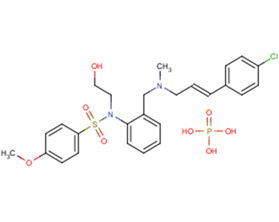
KN-93 Phosphate
CAS No. 1188890-41-6
KN-93 Phosphate( —— )
Catalog No. M17179 CAS No. 1188890-41-6
KN-93 Phosphate is a potent and specific CaMKII inhibitor (Ki: 0.37 μM), no inhibitory for PKC, APK, MLCK or Ca2+-PDE activities.
Purity : >98% (HPLC)
 COA
COA
 Datasheet
Datasheet
 HNMR
HNMR
 HPLC
HPLC
 MSDS
MSDS
 Handing Instructions
Handing Instructions
| Size | Price / USD | Stock | Quantity |
| 2MG | 49 | In Stock |


|
| 10MG | 127 | In Stock |


|
| 25MG | 241 | In Stock |


|
| 100MG | Get Quote | In Stock |


|
| 200MG | Get Quote | In Stock |


|
| 500MG | Get Quote | In Stock |


|
| 1G | Get Quote | In Stock |


|
Biological Information
-
Product NameKN-93 Phosphate
-
NoteResearch use only, not for human use.
-
Brief DescriptionKN-93 Phosphate is a potent and specific CaMKII inhibitor (Ki: 0.37 μM), no inhibitory for PKC, APK, MLCK or Ca2+-PDE activities.
-
DescriptionKN-93 Phosphate is a potent and specific CaMKII inhibitor (Ki: 0.37 μM), no inhibitory for PKC, APK, MLCK or Ca2+-PDE activities.
-
In Vitro——
-
In Vivo——
-
Synonyms——
-
PathwayOthers
-
TargetOther Targets
-
RecptorCaMKII
-
Research AreaOthers-Field
-
Indication——
Chemical Information
-
CAS Number1188890-41-6
-
Formula Weight599.03
-
Molecular FormulaC26H29ClN2O4S·H3PO4
-
Purity>98% (HPLC)
-
Solubility——
-
SMILESCN(C/C=C/c1ccc(cc1)Cl)Cc1ccccc1N(CCO)S(=O)(=O)c1ccc(cc1)OC.OP(=O)(O)O
-
Chemical Name——
Shipping & Storage Information
-
Storage(-20℃)
-
ShippingWith Ice Pack
-
Stability≥ 2 years
Reference
1. Sumi M, et al. Biochem Biophys Res Commun. 1991, 181(3), 968-975.
molnova catalog



related products
-
CY3
Cy3 is an orange-fluorescent label for nucleic acid and protein (λex=554, λem=568).
-
trans-Petroselinic A...
Trans-Petroselinic acid, the trans isomer of petroselinic acid and an isomer of oleic acid, is detected in the milk fat of cows, goats, and ewes, as well as human breast milk.
-
Spermine Tetrahydroc...
Spermine Tetrahydrochloride is used for precipitation of DNA of >100 base pairs in length from low salt aqueous buffers.



 Cart
Cart
 sales@molnova.com
sales@molnova.com


